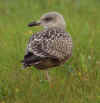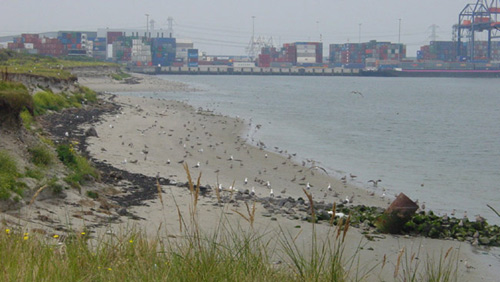first calendar year: August
Last update of this page: 27-09-05 15:09
In August most Dutch LBBG leave the colony at the Maasvlakte, Rotterdam (for locations, see the distribution page). By the end of August, 99% of the adults and their juveniles (approximately 70.000 birds) have left the colonies of the Maasvlakte and start migrating south (at least leave the immediate feeding grounds around the colony). For a while, they gather at the beach near the colonies, in mixed groups of different age-classes.
|
|
Such groups may consist of up to 3.000 LBBG by mid September 2000. In these groups the races graellsii and intermedius are both present. Naming races in juvenile plumage is very difficult, and often only possible when birds are banded / ringed or fed by ringed parents. From mid-October the number of juveniles steadily decreases to several 100s and most Dutch LBBG juveniles have to be sought after in Portugal or further south.
Although racial separation of juveniles is
very difficult, juvenile LBBG is readably different from other
white-headed gull juveniles, Yellow-legged Gull (L. michahellis)
coming closest probably. Nevertheless, when inner primaries and tail together
with moult score and abrasion of scapulars and wing coverts are seen well,
juveniles are quite distinctive.
For long it's known that moult score and
quality (condition) of body feathers is a reliable feature to distinguish michahellis
from LBBG; LBBG being the later hatched, northern breeding species of the
two. Subsequently, when juvenile LBBG and YLG are seen side-by-side in
August and September, YLG often stands out with more abraded scapulars,
tertials and wing coverts, the fringes already worn, centres slightly
bleached and often most scapulars and some coverts moulted to 2nd
generation feathers.
But as the table below shows, some LBBG do moult quickly or early, at least well before departing to the wintering grounds. Half of the sample of juvenile LBBG replace (at least some) mantle feathers and scapulars, as early as "still in the colony and begging for food". The table below shows the results and some examples are shown in the images right.
Nevertheless, direct comparison with michahellis shows on average fresh (warm/dark tinged) second generation feathers on LBBG where michahellis already shows more bleached (i.e. paler) upper-parts, strongly contrasting with the coverts and tertials. Juvenile coverts, scapulars and tertials in michahellis juveniles often show fringes and tips which are heavily worn.
Summarizing, most LBBG juveniles can readily be identified by:
- the dark inner primaries,
- dark centred tertials with narrow straight white fringe,
- pretty neat scapulars and tertials well into September, early October, showing no extreme wear,
- dark brown under-wing coverts,
- dark greater covert bar created by the base of the greater coverts, especially the outer greaters,
- dark chocolate brown centres of scapulars and coverts,
- more black in the tail and more barring on upper-tail coverts.
Separating sub-species of graellsii, intermedius, the intermediate Dutch intergrade and fuscus is hard to do in juveniles, although some general features, to name jizz and contrast in dark base and pale fringes may be indicative. Where most fuscus LBBG lay eggs almost two months later than average Dutch LBBG, it is highly unlikely to find such advanced covert and scapular moult in fuscus juveniles.
Maasvlakte:
1cy LBBG research
research by GRO
Early in the breeding season it was relatively easy to monitor chicks on a regular basis, by measuring them two or three times a week. This allowed accurate estimations of growth rate for the pulli of Category I (hatched before June 10).
For category II & III, which hatched late June, such regular visits to the nests would have much impact on the colony for two reasons. A: early hatched chicks would run away large distances through the colony, making them vulnerable for attacking adults. And B: recently hatched pulli and eggs would be left unattended and nests could be destroyed by predating adults and Herring Gull.
Taking these factors in account, we measured category II & III chicks less intensive. Immediately after hatching, birds were measured and tie wrapped. Only three weeks later, birds were measured again when the darvic rings were attached. Some category II & III birds were measured occasionally in between these dates.

 For some individuals, two
measurements were not sufficient to allocate birds to a certain category,
especially not when hatching was not confirmed. For these individuals we
used two plots, from earlier research by Arie Spaans at Terschelling. In
his paper, he provides several plots, of which two are presented at this
page, below. Spaans estimated growth graphs for LBBG juveniles in 1992 and
1993. 1992 proved to be a year with food shortage, in 1993 food supply was
not a limiting factor in daily growth rate. Growth rate was measured by
body mass increment and wing length.
For some individuals, two
measurements were not sufficient to allocate birds to a certain category,
especially not when hatching was not confirmed. For these individuals we
used two plots, from earlier research by Arie Spaans at Terschelling. In
his paper, he provides several plots, of which two are presented at this
page, below. Spaans estimated growth graphs for LBBG juveniles in 1992 and
1993. 1992 proved to be a year with food shortage, in 1993 food supply was
not a limiting factor in daily growth rate. Growth rate was measured by
body mass increment and wing length.
the Netherlands: 'Dutch intergrade'
 LBBG
1cy B16 E August
22 2002, Missouriweg, Maasvlakte, the
Netherlands.
LBBG
1cy B16 E August
22 2002, Missouriweg, Maasvlakte, the
Netherlands.  LBBG
1cy C95 E
August 31 2003, Amsterdam, the Netherlands.
LBBG
1cy C95 E
August 31 2003, Amsterdam, the Netherlands.  LBBG
1cy E15 E August
14 2003, Nachtegalenkeet, Maasvlakte, the
Netherlands.
LBBG
1cy E15 E August
14 2003, Nachtegalenkeet, Maasvlakte, the
Netherlands.  LBBG
1cy E21 E August
14 2003, Nachtegalenkeet, Maasvlakte, the
Netherlands.
LBBG
1cy E21 E August
14 2003, Nachtegalenkeet, Maasvlakte, the
Netherlands.  LBBG
1cy E24 E August
14 2003, Nachtegalenkeet, Maasvlakte, the
Netherlands.
LBBG
1cy E24 E August
14 2003, Nachtegalenkeet, Maasvlakte, the
Netherlands.  LBBG
1cy E31 E
August 14 2003, Nachtegalenkeet, Maasvlakte, the Netherlands.
LBBG
1cy E31 E
August 14 2003, Nachtegalenkeet, Maasvlakte, the Netherlands.  LBBG
1cy E54 E
August 06 2004, Dintelhaven, Maasvlakte, the Netherlands.
LBBG
1cy E54 E
August 06 2004, Dintelhaven, Maasvlakte, the Netherlands. LBBG
x YLG 1cy E56 E
August 06 2004, Dintelhaven, Maasvlakte, the Netherlands. Hybrid from
female CU9.
LBBG
x YLG 1cy E56 E
August 06 2004, Dintelhaven, Maasvlakte, the Netherlands. Hybrid from
female CU9. LBBG
1cy E65 E
August 06 2004, Dintelhaven, Maasvlakte, the Netherlands.
LBBG
1cy E65 E
August 06 2004, Dintelhaven, Maasvlakte, the Netherlands. LBBG
1cy E66 E
August 06 2004, Dintelhaven, Maasvlakte, the Netherlands.
LBBG
1cy E66 E
August 06 2004, Dintelhaven, Maasvlakte, the Netherlands. LBBG
1cy E76 E
August 06 2004, Maasvlakte, the Netherlands.
LBBG
1cy E76 E
August 06 2004, Maasvlakte, the Netherlands. LBBG
1cy E87 E
August 06 2004, Maasvlakte, the Netherlands.
LBBG
1cy E87 E
August 06 2004, Maasvlakte, the Netherlands. LBBG
1cy E90 E
August 06 2004, Maasvlakte, the Netherlands.
LBBG
1cy E90 E
August 06 2004, Maasvlakte, the Netherlands. LBBG
1cy E169 E August
06 2004, Nachtegalenkeet, Maasvlakte, the Netherlands.
LBBG
1cy E169 E August
06 2004, Nachtegalenkeet, Maasvlakte, the Netherlands. LBBG
1cy E173 E
August 06 2004, Maasvlakte, the Netherlands.
LBBG
1cy E173 E
August 06 2004, Maasvlakte, the Netherlands. LBBG
1cy E800 E
August 06 2004, Dintelhaven, Maasvlakte, the Netherlands.
LBBG
1cy E800 E
August 06 2004, Dintelhaven, Maasvlakte, the Netherlands. LBBG
1cy 5.364.435 August
28 2003, IJmuiden, the
Netherlands.
LBBG
1cy 5.364.435 August
28 2003, IJmuiden, the
Netherlands. 2cy
LBBG 5.179.990
June 12 2005, Amsterdam, the Netherlands. Pullus born near Amsterdam.
2cy
LBBG 5.179.990
June 12 2005, Amsterdam, the Netherlands. Pullus born near Amsterdam. LBBG 1cy
L-902232 August
17 2005, Westkapelle, the Netherlands.
LBBG 1cy
L-902232 August
17 2005, Westkapelle, the Netherlands.Norway: intermedius
 LBBG
1cy Stavanger August
28 2003, IJmuiden, the
Netherlands. Ringed in Norway.
LBBG
1cy Stavanger August
28 2003, IJmuiden, the
Netherlands. Ringed in Norway.unringed LBBG
 Photo
1: LBBG 1cy, August 24 2000, Etaples, France.
Photo
1: LBBG 1cy, August 24 2000, Etaples, France. Photo
2: LBBG 1cy, August 16 2001, Missouriweg Maasvlakte, the Netherlands.
Photo
2: LBBG 1cy, August 16 2001, Missouriweg Maasvlakte, the Netherlands. Photo
3: LBBG 1cy, August 18 2001, Dintelhaven Maasvlakte, the Netherlands.
Photo
3: LBBG 1cy, August 18 2001, Dintelhaven Maasvlakte, the Netherlands. Photo
4: LBBG 1cy, August 22 2002, Dintelhaven Maasvlakte, the
Netherlands. A very pale individual.
Photo
4: LBBG 1cy, August 22 2002, Dintelhaven Maasvlakte, the
Netherlands. A very pale individual. Photo
5: LBBG 1cy, August 22 2002, Papegaaienbek, Maasvlakte, the
Netherlands. A pale individual with broad fringes on wing-coverts and
scapulars.
Photo
5: LBBG 1cy, August 22 2002, Papegaaienbek, Maasvlakte, the
Netherlands. A pale individual with broad fringes on wing-coverts and
scapulars.